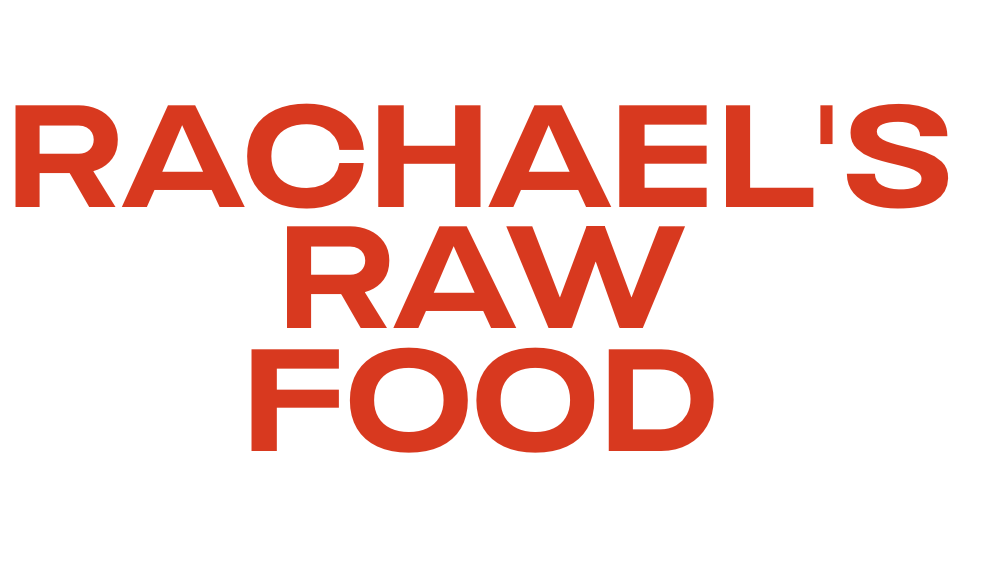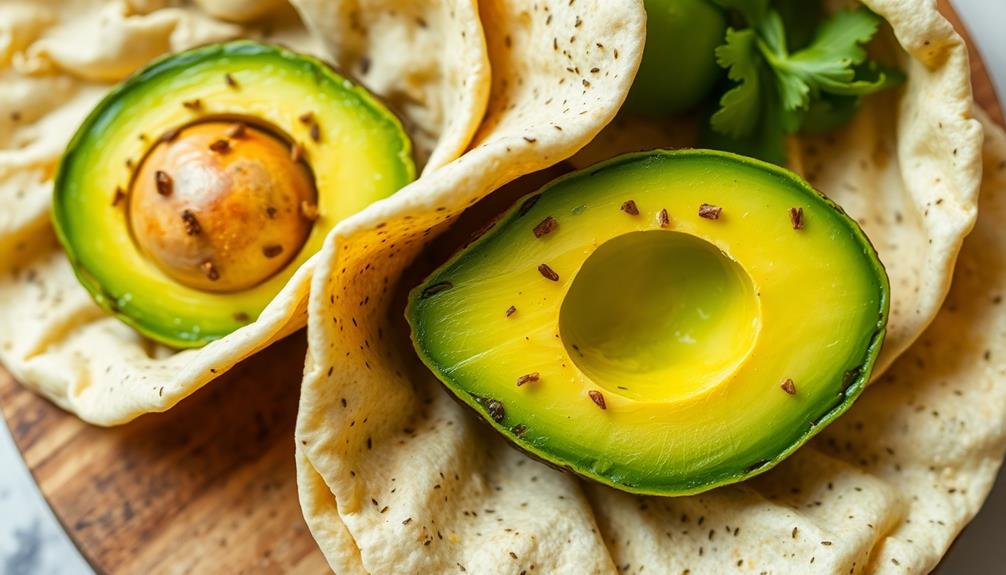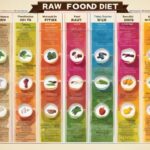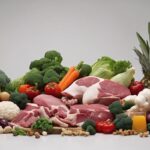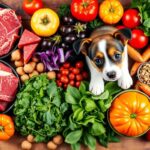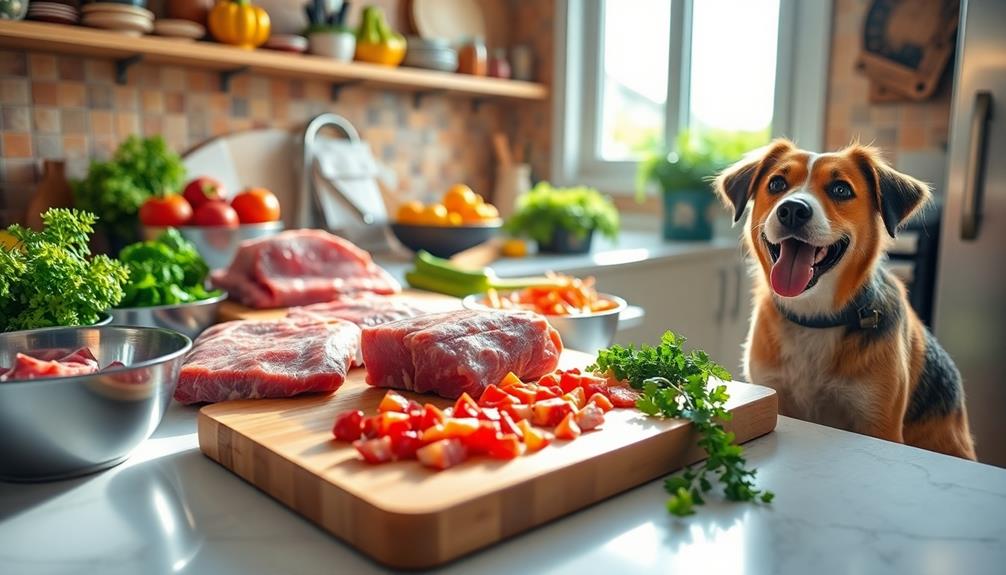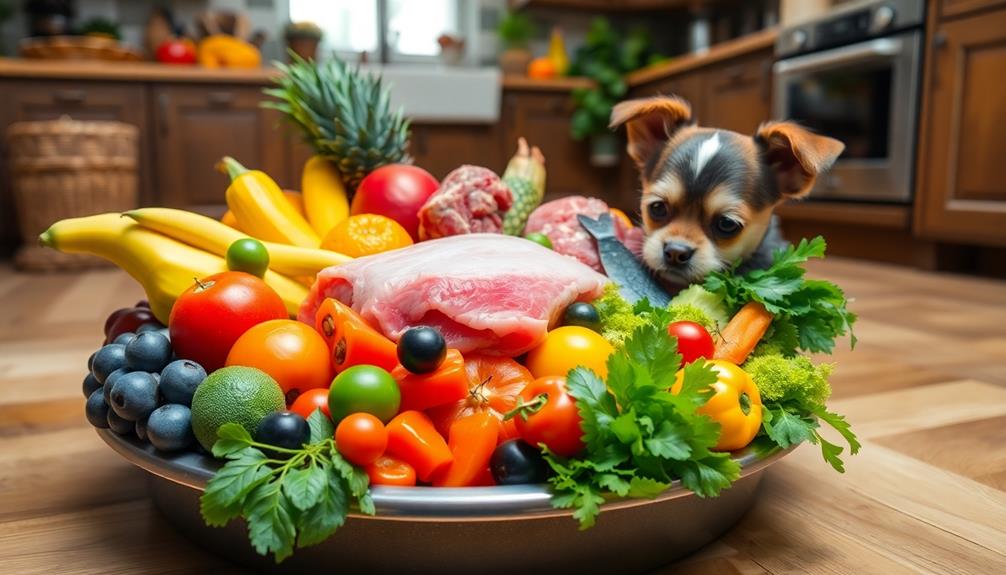Shifting your dog to a raw food diet can greatly enhance their health. Start by understanding that raw diets mimic what wild canines eat, focusing on muscle meat, organs, and bones. Aim for a balanced diet with a 64:8:8:20 ratio of protein, bones, organ meat, and veggies. Gradually introduce raw food over 7-10 days, monitoring your dog's stool for changes. You'll see improvements in digestion, energy, and coat health. Be mindful of proper hygiene to avoid contamination. If you're curious about the best protein sources and how to make the change, stick around for more insights.
Key Takeaways
- Transition your dog gradually to a raw diet over 7-10 days, starting with 25% raw food mixed with their current diet.
- Follow the 64:8:8:20 nutritional ratio: 64% muscle meat, 8% bones, 8% organ meats, and 20% vegetables/fruits.
- Incorporate high-quality, fresh protein sources like beef, chicken, and fish, while avoiding processed meats.
- Ensure proper hygiene and handling to minimize bacterial contamination risks, including freezing raw meat for safety.
- Monitor your dog's health and adjust protein sources to avoid allergens and maintain balanced nutrition.
Understanding Raw Dog Food
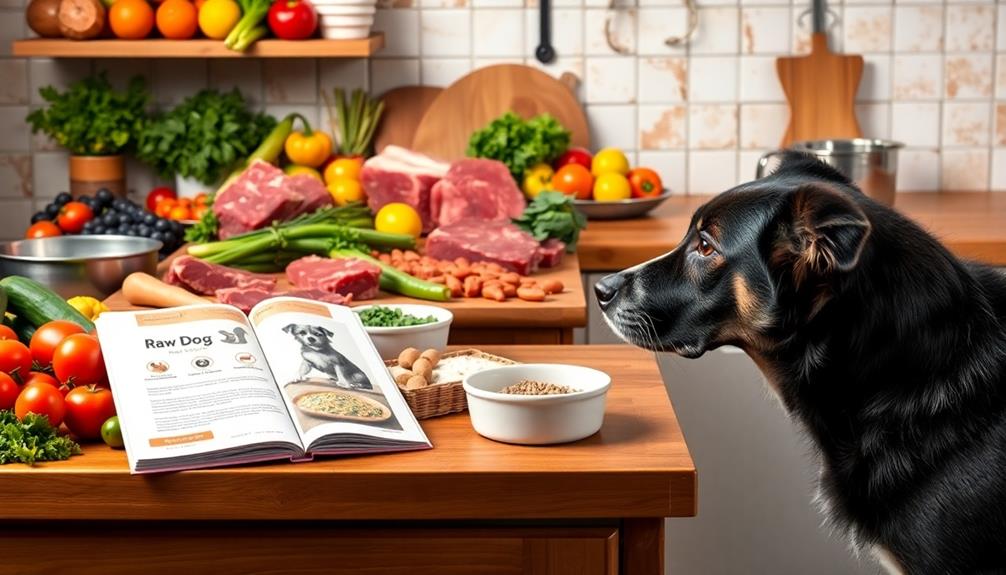
Understanding raw dog food means recognizing that it mimics the natural diet of wild canines. This type of diet consists of uncooked animal parts, including muscle meat, organs, and bones, all of which are crucial for your dog's health. A nutritionally balanced raw dog food diet can promote peak health and well-being by providing the high-quality protein that your dog needs.
Dogs are equipped with strong stomach acid and enzymes that help them safely digest raw meat, effectively neutralizing pathogens that could be present. When you consider feeding your dog raw food, it's important to verify that their dietary needs are met. Typically, a general guideline suggests feeding 2-3% of your dog's body weight daily, allowing you to tailor the portions according to their size and activity level.
While some owners may choose to add fruits and vegetables, these aren't necessary for a balanced diet. The primary focus should always be on high-quality protein sources.
Brands like We Feed Raw offer pre-packaged options that cater to these needs, guaranteeing your dog gets a complete and balanced raw diet without the risk of nutrient deficiencies.
Nutritional Balance Guidelines

When it comes to feeding your dog a raw food diet, striking the right nutritional balance is important. A well-balanced raw dog food diet typically follows the 64:8:8:20 ratio, ensuring your pup gets all the necessary nutrients they need.
Here's a quick breakdown:
- Muscle Meat (64%): This serves as the primary source of protein and fat, fueling your dog's energy needs.
- Bones (8%): Essential for calcium and minerals, bones help prevent deficiencies that can arise from an all-meat diet.
- Secreting Organs (8%): These are rich in vitamins and minerals that support overall health.
- Vegetables and Fruits (20%): They provide fiber and additional nutrients, contributing to a balanced diet.
For adult dogs, aim for 2-3% of their body weight in raw food daily.
Puppies and active dogs may require more to support their growth and energy levels.
Don't forget to monitor your dog's health regularly and adjust their diet as necessary to maintain that important nutritional balance.
Transitioning to Raw Diet
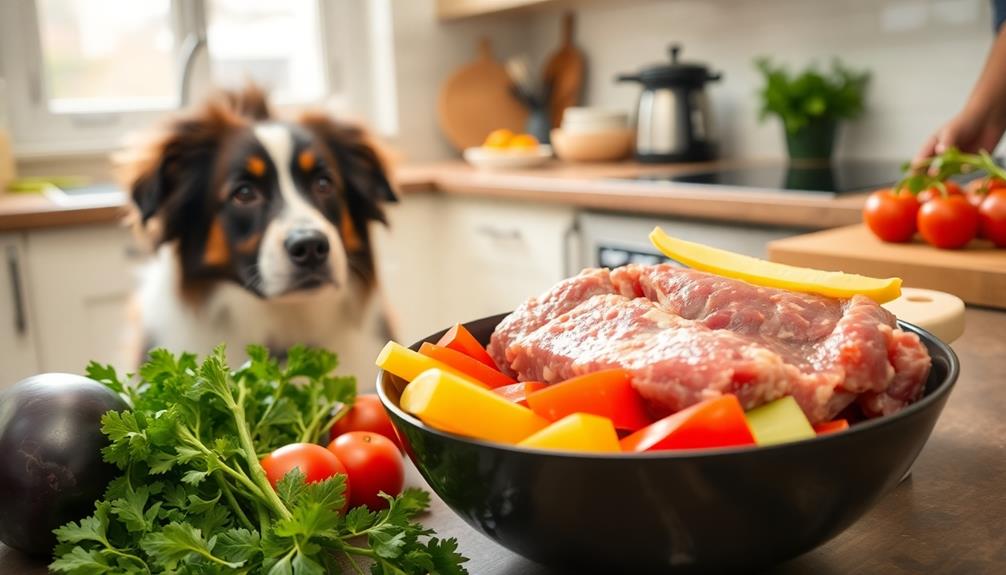
Shifting your dog to a raw food diet can be an exciting change, but it requires a careful approach to guarantee their digestive system adapts smoothly. Start by gradually changing over 7-10 days. Begin with 25% raw food mixed with 75% of their current diet. Follow this plan:
| Day | Raw Food % | Current Diet % |
|---|---|---|
| 1-3 | 25% | 75% |
| 4-6 | 50% | 50% |
| 7-9 | 75% | 25% |
| 10 | 100% | 0% |
During this time, monitor your dog's stool quality. Changes can signal the need for dietary adjustments or a slower change. Introduce one protein source at a time to help identify any potential food sensitivities or allergies.
Don't forget hygiene; wash your hands and clean surfaces to reduce bacterial contamination. Finally, consult with your veterinarian for personalized advice based on your dog's health needs and lifestyle. This careful approach guarantees a smoother change to a raw diet for your furry friend.
Benefits of Raw Feeding
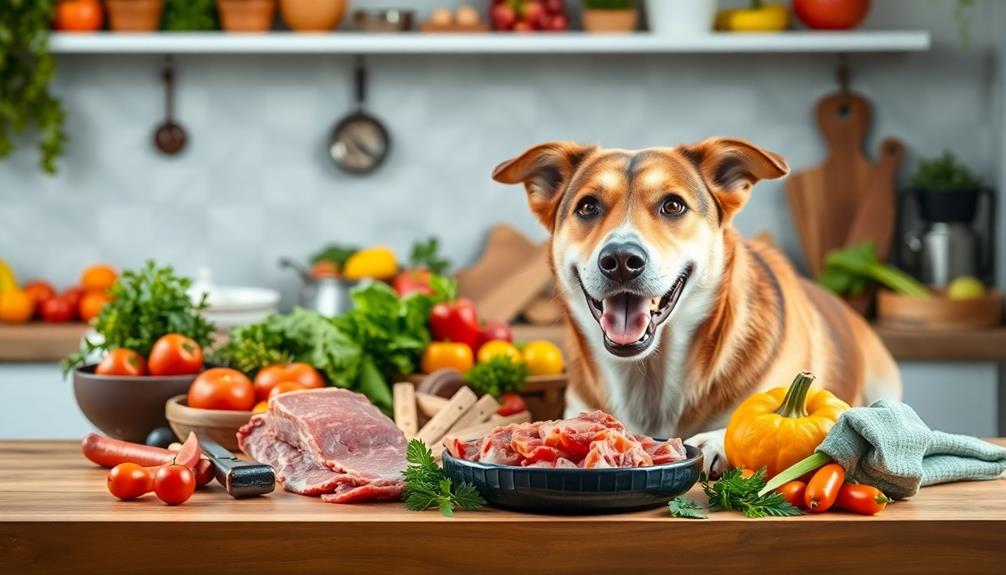
Embracing a raw food diet for your dog can reveal numerous health benefits, making it a popular choice among pet owners.
By opting for a raw diet, you're not just changing what your dog eats; you're enhancing their overall well-being.
Here are some key benefits you might notice:
- Improved Digestion: Raw feeding often leads to better nutrient absorption, resulting in smaller, firmer stools.
- Enhanced Skin and Coat: The natural fats and oils in raw diets can give your dog's skin a healthier appearance and contribute to a shinier coat.
- Increased Energy Levels: Many dog owners report that their pets have more liveliness on a raw diet, with 90% noting healthy weight maintenance.
- Stronger Immune System: The natural ingredients in a raw diet can help bolster your dog's immune system, making them less prone to allergies and food sensitivities.
Common Concerns Addressed

You might've some concerns about the safety of raw feeding, the costs involved, and how to shift your dog smoothly.
It's important to address these issues so you can feel confident in making the switch.
Let's explore how to tackle these common worries effectively.
Safety of Raw Feeding
While the idea of feeding your dog a raw diet can be appealing, concerns about safety often arise.
It's important to address these safety concerns to guarantee both you and your furry friend stay healthy. Here are some key points to ponder:
- Bacterial Contamination: Raw meat can harbor harmful bacteria. Proper handling and hygiene practices are essential to prevent foodborne illnesses.
- Freezing Raw Meat: Freezing raw meat for at least 3-4 days can kill parasites, considerably reducing health risks associated with raw diets.
- High-Quality Ingredients: Always source high-quality, fresh ingredients to minimize the risk of contamination and guarantee balanced nutrition.
- Regular Vet Check-Ups: Regular vet check-ups are critical when making a shift to a raw diet. Monitoring for allergies or sensitivities guarantees your dog's health and well-being.
Cost Considerations
Shifting to a raw food diet for your dog often raises questions about costs. Initially, raw dog food may seem pricier than traditional kibble, with prices ranging from $2 to $5 per pound. On average, you might find that raw feeding costs about 30% more than kibble.
However, many pet owners discover that the health benefits, like improved health and reduced vet bills, offset this higher cost.
To make raw feeding more budget-friendly, consider bulk purchasing or local sources. Buying in bulk can greatly lower your overall expenses. Additionally, subscription services for raw dog food often provide cost savings through regular deliveries, making it easier to manage monthly expenses.
Many dog owners also report that the reduced need for supplements and lower veterinary costs due to better health balance out the initial investment in raw feeding.
As your dog enjoys the nutritional benefits of a raw diet, you may find that the value gained in their health and well-being far outweighs the financial considerations.
In the end, investing in your dog's diet can lead to a happier, healthier life.
Transitioning Process
Changing your dog to a raw food diet can be a rewarding process, but it requires careful planning and patience. To guarantee a smooth adjustment process, follow these steps:
- Gradually introduce raw food: Over 7-10 days, mix small amounts of raw food into your dog's current diet. Start with 25% raw and increase to 100% by Day 10 to prevent digestive upset.
- Monitor your dog's stool: Keep an eye on the quality and frequency of your dog's stool during the adjustment. Changes can indicate if adjustments are needed.
- Introduce protein sources one at a time: This helps identify any potential food allergies or sensitivities your dog may have, allowing for necessary adjustments.
- Practice proper hygiene: Handle raw food with care to minimize the risk of bacterial contamination. Guarantee safe food preparation to keep your dog healthy.
Choosing Protein Sources
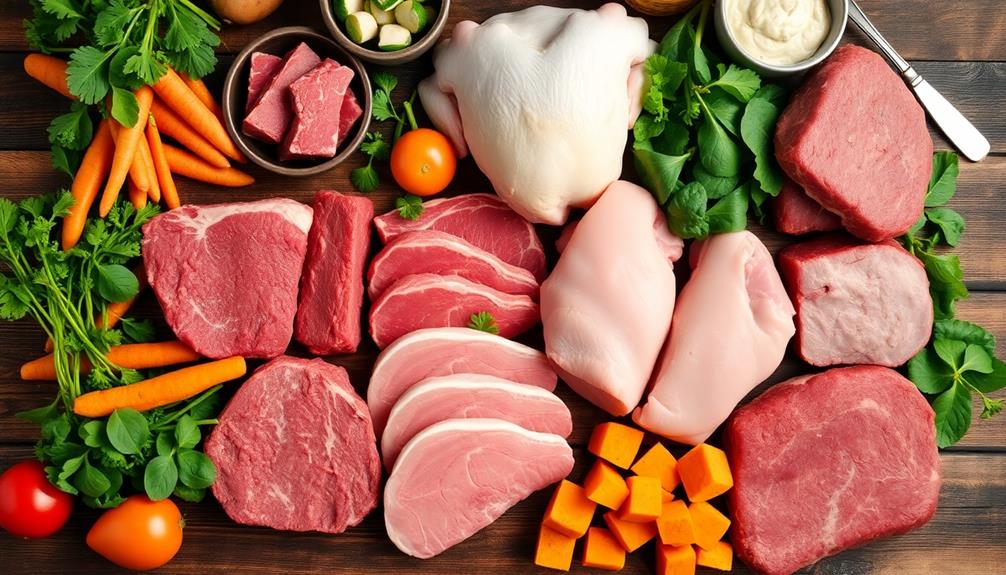
When choosing protein sources for your dog's raw diet, focus on fresh meats like beef, chicken, turkey, lamb, and fish.
Don't forget to incorporate organ meats like liver and heart to boost essential nutrients.
Steering clear of processed proteins will help you maximize the health benefits for your furry friend.
Selecting Raw Meats
Selecting the right raw meats for your dog's diet is essential for their health and well-being. To guarantee your pup gets complete nutrition, focus on high-quality, fresh protein sources. Here's a quick guide to help you choose:
- Variety: Incorporate a mix of lean meats like beef, chicken, turkey, lamb, and fish. This variety provides different nutrients and keeps meals interesting.
- Fat-to-Protein Ratio: Aim for a balanced raw diet with a fat-to-protein ratio of 10%-20%. Include both lean meats and higher-fat options to supply essential fatty acids.
- Monitor Allergens: Keep an eye on your dog for potential allergens. If you notice sensitivities, consider rotating protein sources. While chicken and beef are common allergens, turkey and lamb might be more suitable.
- Avoid Processed Meats: Stick to raw, whole cuts. Processed meats often contain additives and preservatives that can compromise your dog's health.
Incorporating Organ Meats
Incorporating organ meats into your dog's raw food diet is a game-changer for their overall health. These nutrient-dense foods provide essential vitamins and minerals that support various bodily functions. Aim for organ meats to make up about 10-15% of the diet, with liver contributing 10% due to its high vitamin A content. The heart should represent about 5% of their diet, promoting heart health thanks to its taurine-rich profile.
To help you grasp the importance of organ meats, here's a quick breakdown:
| Organ Meat | Percentage of Diet | Key Nutrients |
|---|---|---|
| Liver | 10% | High vitamin A content |
| Heart | 5% | Taurine for heart health |
| Kidneys/Pancreas | 5-10% | Diverse nutrients |
Remember to gradually introduce organ meats to your dog's raw diet to prevent digestive upset. Start with small amounts, monitor their reaction, and adjust accordingly. Incorporating a variety of organ meats not only enhances the nutritional profile but also mimics the natural consumption patterns of wild canines, ensuring your furry friend gets all the nutrients they need.
Avoiding Processed Proteins
Steering clear of processed proteins is crucial for your dog's raw food diet. Processed meats often contain harmful additives that can diminish the nutritional value of your pet's meals. Instead, focus on high-quality, fresh, raw meats to guarantee your dog gets the best nutrition possible.
Here are some key protein sources to evaluate:
- Lean Meats: Include options like beef, chicken, turkey, and lamb. Balance these with higher-fat meats to maintain a healthy fat content of 10%-20%.
- Organ Meats: Incorporate liver as it should make up about 10% of the diet, providing essential vitamins and minerals. Heart should account for 5% for its taurine content.
- Fish: This is a great source of omega-3 fatty acids and adds variety to your dog's meal.
- Rotating Proteins: Monitor for potential allergens and rotate your protein sources to offer a wide range of nutrients and minimize sensitivities.
Always source your meats from high-quality, ethically sourced suppliers, ideally USDA-certified, to confirm safety and nutrition.
Your commitment to avoiding processed proteins will greatly benefit your dog's health!
Incorporating Vegetables and Fruits
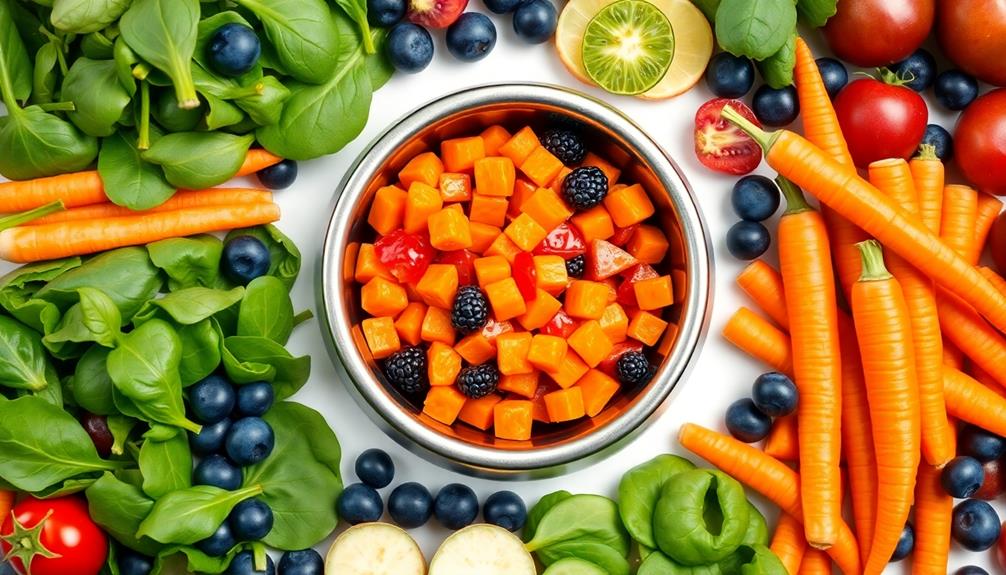
Adding vegetables and fruits to your dog's raw diet can remarkably boost their overall health. By incorporating vegetables and fruits, you provide essential vitamins, minerals, and fiber, which are vital for their well-being. Aim for about 10%-15% of their total diet to consist of these wholesome additions.
Here's a quick reference table for safe and beneficial options:
| Food Type | Safe Options | Toxic Foods for Dogs |
|---|---|---|
| Vegetables | Carrots, Spinach, Sweet Potatoes | Onions, Garlic |
| Fruits | Blueberries, Apples | Grapes, Avocados |
| Benefits | Antioxidants, Nutrients | Serious Health Issues |
To enhance digestibility and nutrient absorption, you should always blend or chop the vegetables and fruits before adding them to the raw diet. While not strictly essential, these produce items can contribute greatly to a more balanced diet, ensuring your dog receives a diverse range of nutrients. Always be vigilant about avoiding toxic foods for dogs to keep your furry friend happy and healthy!
Bone Management Strategies
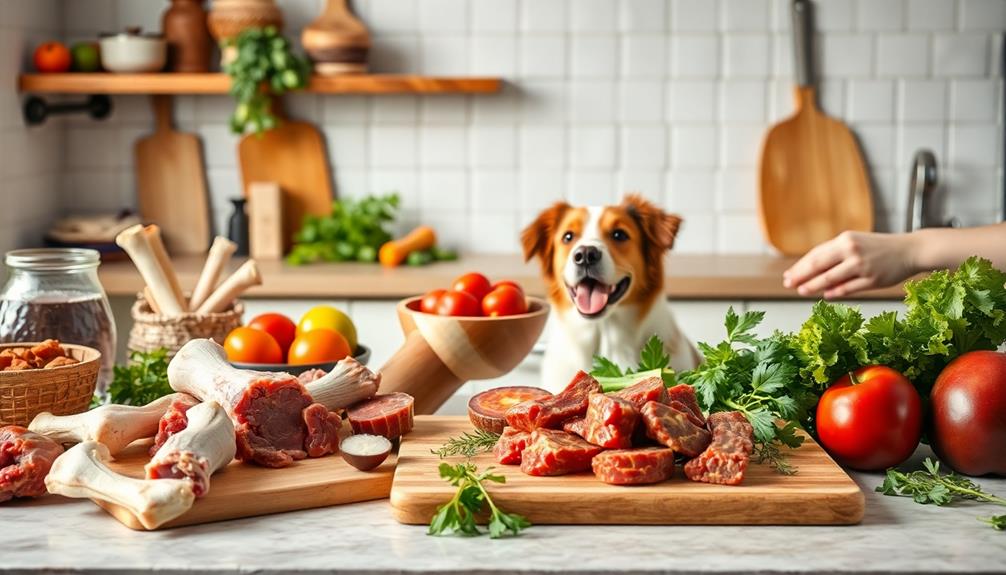
While vegetables and fruits play a significant role in your dog's raw diet, bone management is equally important for their health. Proper bone selection and management guarantee your dog receives essential nutrients while minimizing risks. Here are some key strategies to take into account:
- Choose Meaty Bones: Opt for meaty bones with joints, like necks and tails, for both nutritional benefits and safety. Avoid weight-bearing bones as they can cause broken teeth or digestive issues.
- Adjust Bone Content: For adult dogs, about 10-15% of their diet should consist of raw bones, while puppies need a bit more at 12-15% to support their growth and development.
- Monitor Bone Types: Different bones have varying percentages of bone mass. For example, turkey necks are about 42% bone. Adjust your dog's diet accordingly to meet their calcium needs.
- Evaluate Bone Meal: If your dog can't consume raw bones, bone meal can be a great alternative. Use about 2 teaspoons of bone meal per pound of food to guarantee they get adequate calcium.
Essential Nutrients Overview
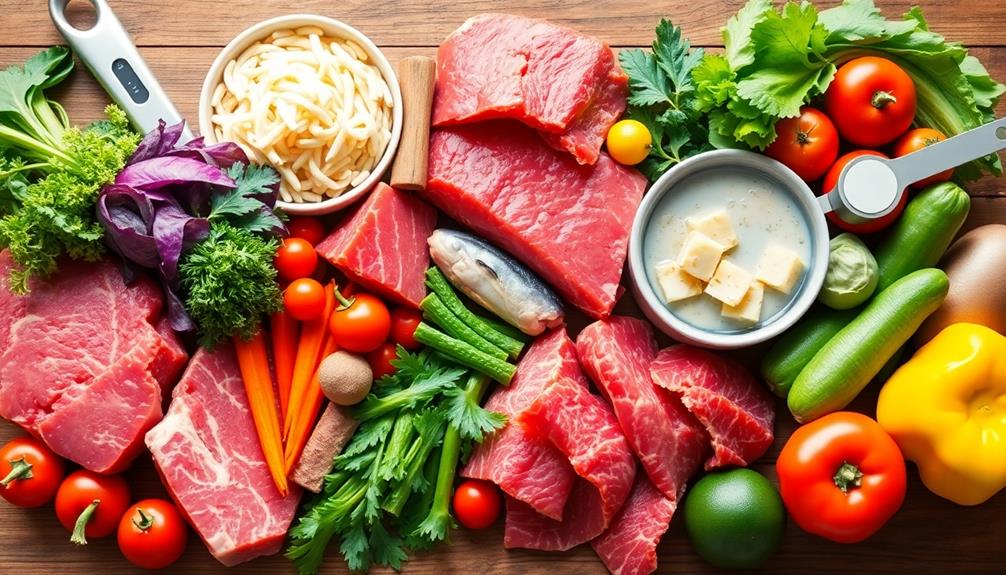
Understanding the essential nutrients your dog needs is critical for crafting a balanced raw food diet. To guarantee your pup thrives, focus on high-quality protein sources, including meats and fish.
Educational toys, such as those in the Healthy Kid Play collection, can also be a fun way to teach children about the importance of nutrition for pets. Essential fatty acids, particularly omega-3 fatty acids from fatty fish like salmon, support heart and skin health, while vitamins and minerals from fruits and vegetables enhance overall well-being.
Include important organ meats in your dog's diet, as they provide necessary vitamins and minerals. Aim for about 10% of the diet to consist of organ meats, especially liver, and about 5% from heart to maintain proper taurine levels.
Calcium and phosphorus are also significant for bone health, so make sure your dog's diet contains 10-15% bone content for adults and 12-15% for puppies.
For ideal nutrient balance, adhere to established ratios like the 64:8:8:20 ratio (meat, bones, offal, and vegetables/fruits). This way, you'll confirm your dog receives all the essential nutrients they need for a healthy, active life.
Resources for Raw Feeding

When you're starting your dog on raw food, having the right resources can make all the difference.
Online communities and blogs provide valuable insights and support, while subscription services guarantee you get high-quality ingredients delivered right to your door.
With these tools at your fingertips, you'll find it easier to navigate the raw feeding journey.
Online Communities and Forums
Numerous online communities and forums dedicated to raw feeding can be invaluable resources for dog owners.
These platforms allow you to connect with fellow pet parents who share their experiences, tips, and advice on adapting dogs to a raw diet, fostering collective learning and support.
Here are some benefits you can access through these online communities:
- Meal Plans: Many groups provide structured meal plans tailored to various dog sizes and activity levels, ensuring balanced nutrition.
- Nutritional Calculations: You can find tools and guidance for calculating the right nutrient ratios, helping you make informed decisions about your dog's diet.
- High-Quality Ingredients: Members often share recommendations for sourcing high-quality ingredients, ensuring your dog gets the best nutrition possible.
- Success Stories: Engaging with these communities allows you to read inspiring success stories from other dog owners, motivating you on your raw feeding journey.
Whether through social media platforms or dedicated websites, these online communities keep you informed and motivated about raw feeding, ensuring your dog enjoys peak nutrition and health.
Educational Blogs and Articles
Exploring educational blogs and articles on raw feeding can greatly enhance your knowledge and confidence as you begin this journey with your dog. These resources often emphasize the importance of a balanced raw diet, detailing the ideal ratios of meat, bones, and organ meats to achieve peak health.
Here's a quick reference table to guide you:
| Aspect | Recommendation | Importance |
|---|---|---|
| Daily Food Portions | 2-3% of body weight | Guarantees proper nutrition |
| Shifting Dogs | Gradual introduction (7-10 days) | Minimizes digestive upset |
| Organ Meats | 10-15% of the raw diet | Provides essential vitamins |
| Safety Measures | Proper hygiene and handling practices | Reduces bacterial contamination |
| Nutritional Balance | Meat, bones, and organ meats ratio | Supports overall health |
Subscription Service Options
Many pet owners find subscription services for raw dog food to be a game-changer in their feeding routines.
These services offer convenient, regular deliveries of high-quality, ethically sourced ingredients tailored to meet your dog's nutritional needs.
Here are some benefits you can enjoy with subscription services:
- Customizable Meal Plans: You can create meal plans based on your dog's size, age, and dietary preferences, ensuring a balanced and varied diet.
- Cost-Effective Options: Many services provide significant savings compared to retail purchases, making raw feeding more accessible for you.
- Diverse Meal Types: Choose from freeze-dried meals, frozen options, or fresh raw meals, all catering to your storage and preparation preferences.
- Educational Resources: Gain access to blogs and guides that support you in changing to and maintaining a raw diet.
Frequently Asked Questions
How Do You Start a Dog on a Raw Food Diet?
To start your dog on a raw food diet, ease into it. Mix 25% raw with their current food, gradually increasing to 100% by Day 10, while monitoring their stool for adjustments.
What Are the Guidelines for Raw Food for Dogs?
When feeding your dog raw food, make certain it's balanced: 70-80% meat, 10-15% bones, and 5-10% organs. Introduce it gradually over 7-10 days and maintain hygiene to prevent contamination. Always source high-quality ingredients.
Can I Just Switch My Dog to Raw Food?
You can't just switch your dog to raw food overnight. Gradually moving over 7-10 days helps prevent digestive issues. Start with a mix, monitor their stool, and adjust as needed for a smoother adjustment.
How Long Does It Take for a Dog to Adjust to Raw Food?
You'd think switching to raw food's a breeze, but it actually takes your dog about 7-10 days to adjust. Gradual shifts help their tummy adapt, so patience is key for a smooth process.
Conclusion
Incorporating a raw food diet for your dog can feel like starting on a new adventure, much like venturing into uncharted waters. Remember the first time you paddled out on a kayak? At first, it seemed intimidating, but soon you found your rhythm. Just like that, with patience and knowledge, you'll navigate this journey. By prioritizing balance and well-being, you're not just feeding your dog; you're enriching their life, ensuring they thrive with every meal.
